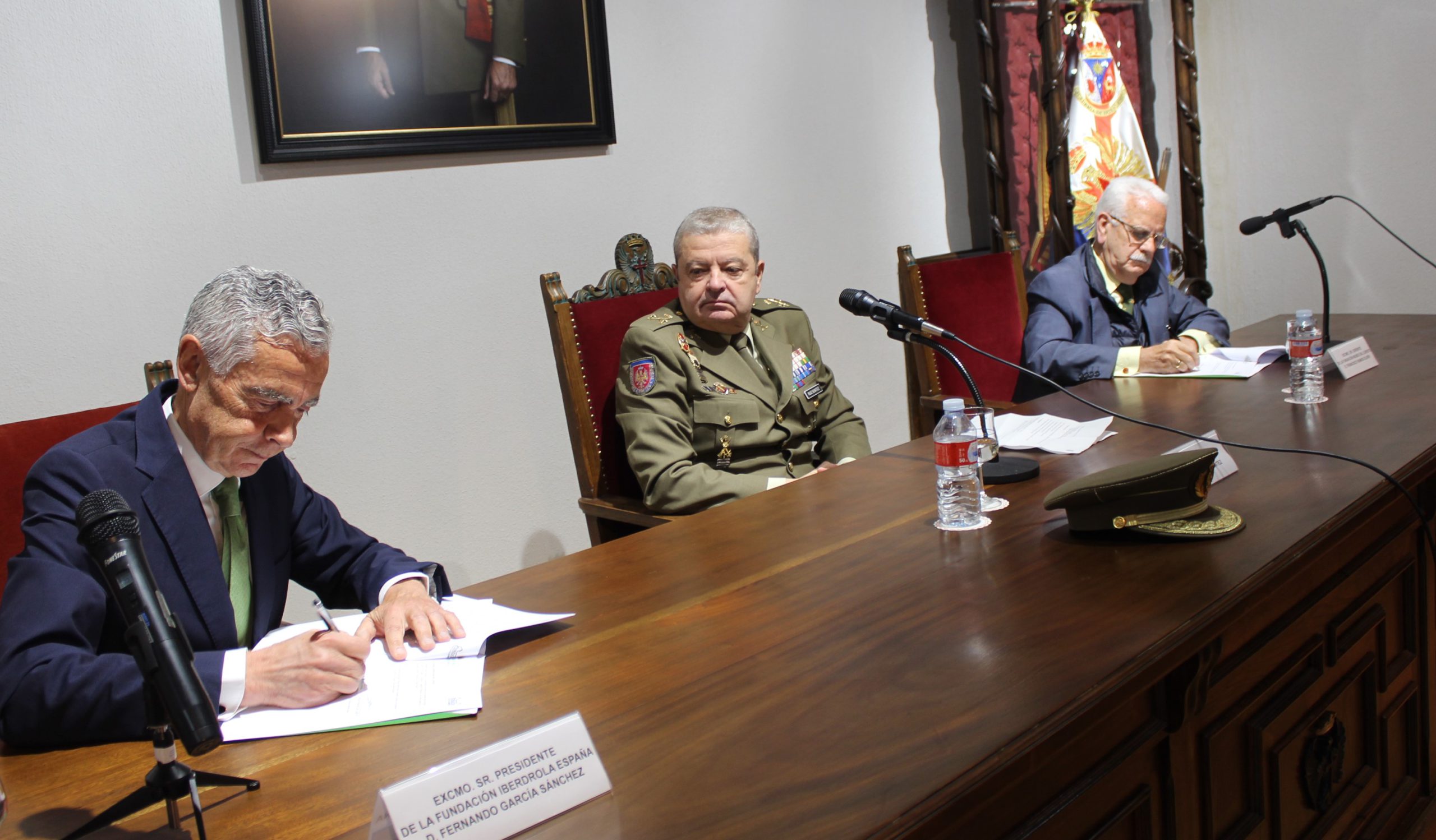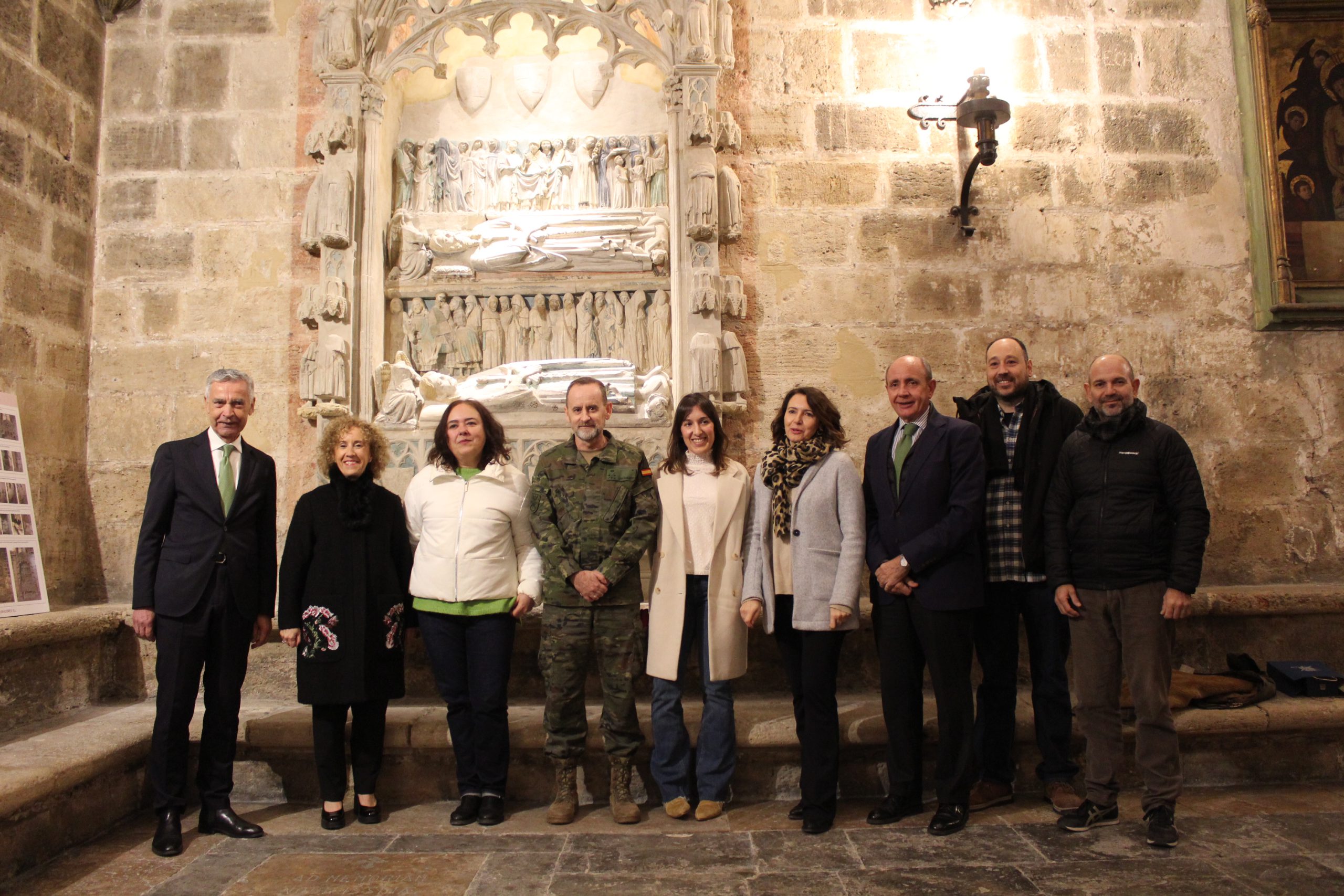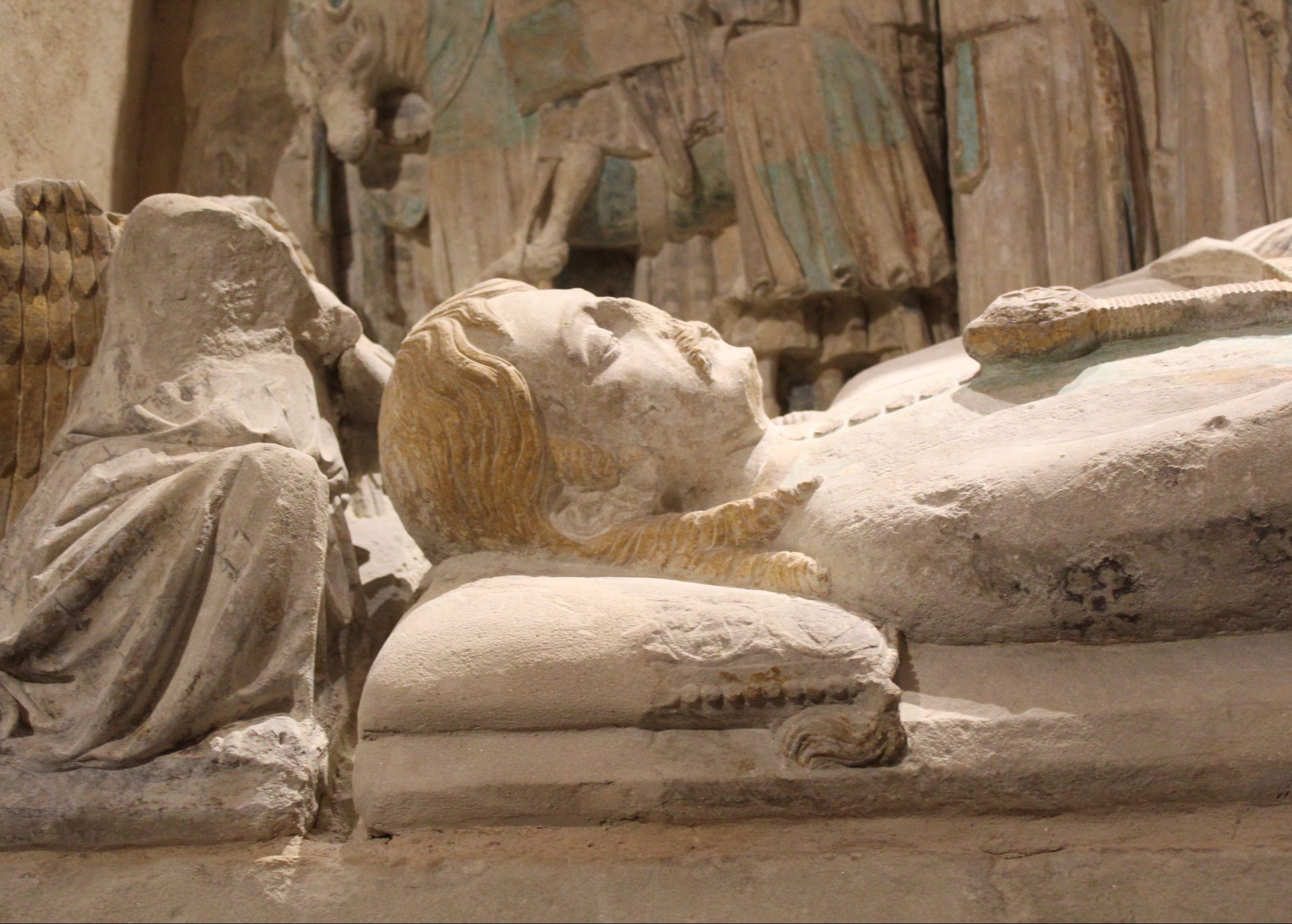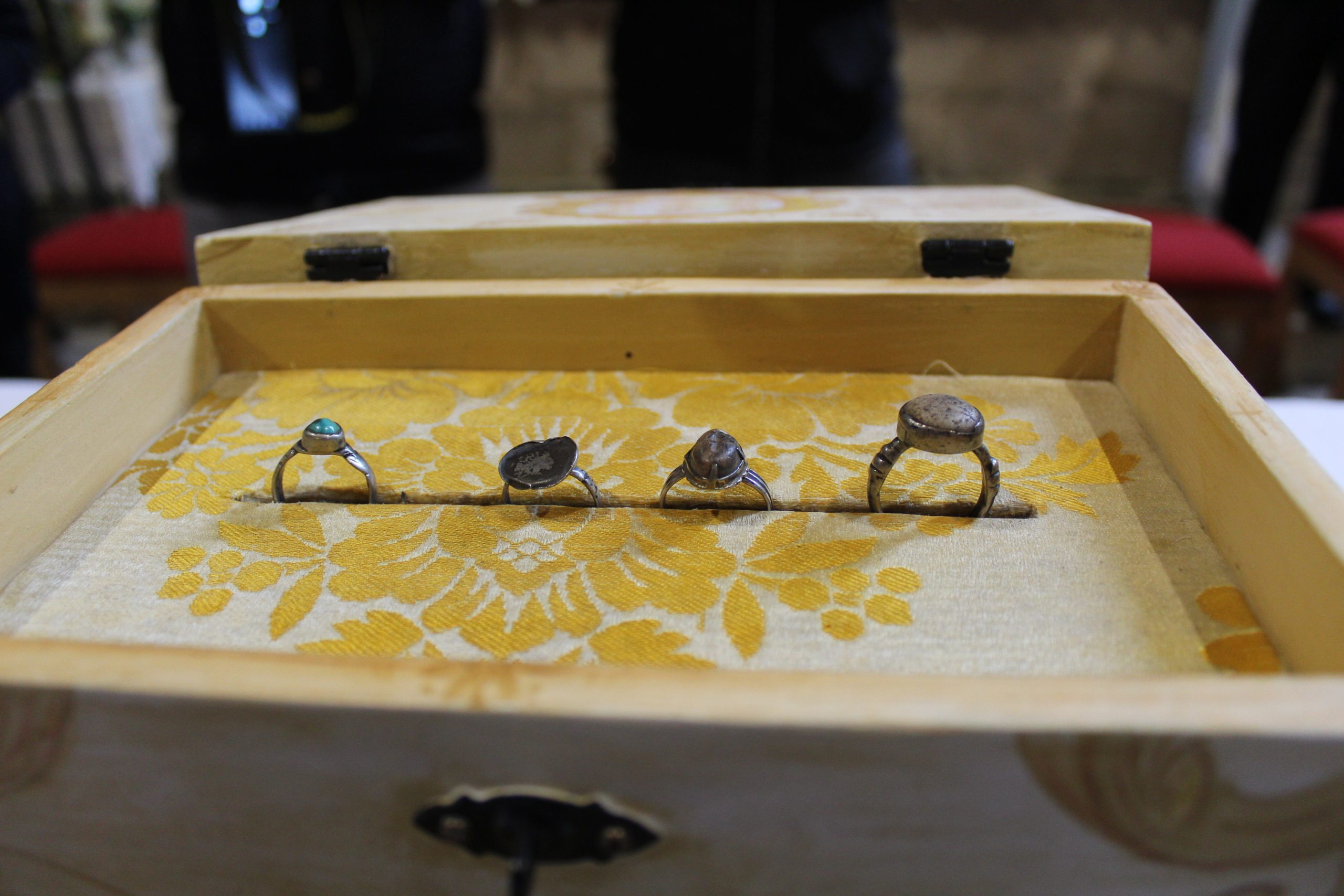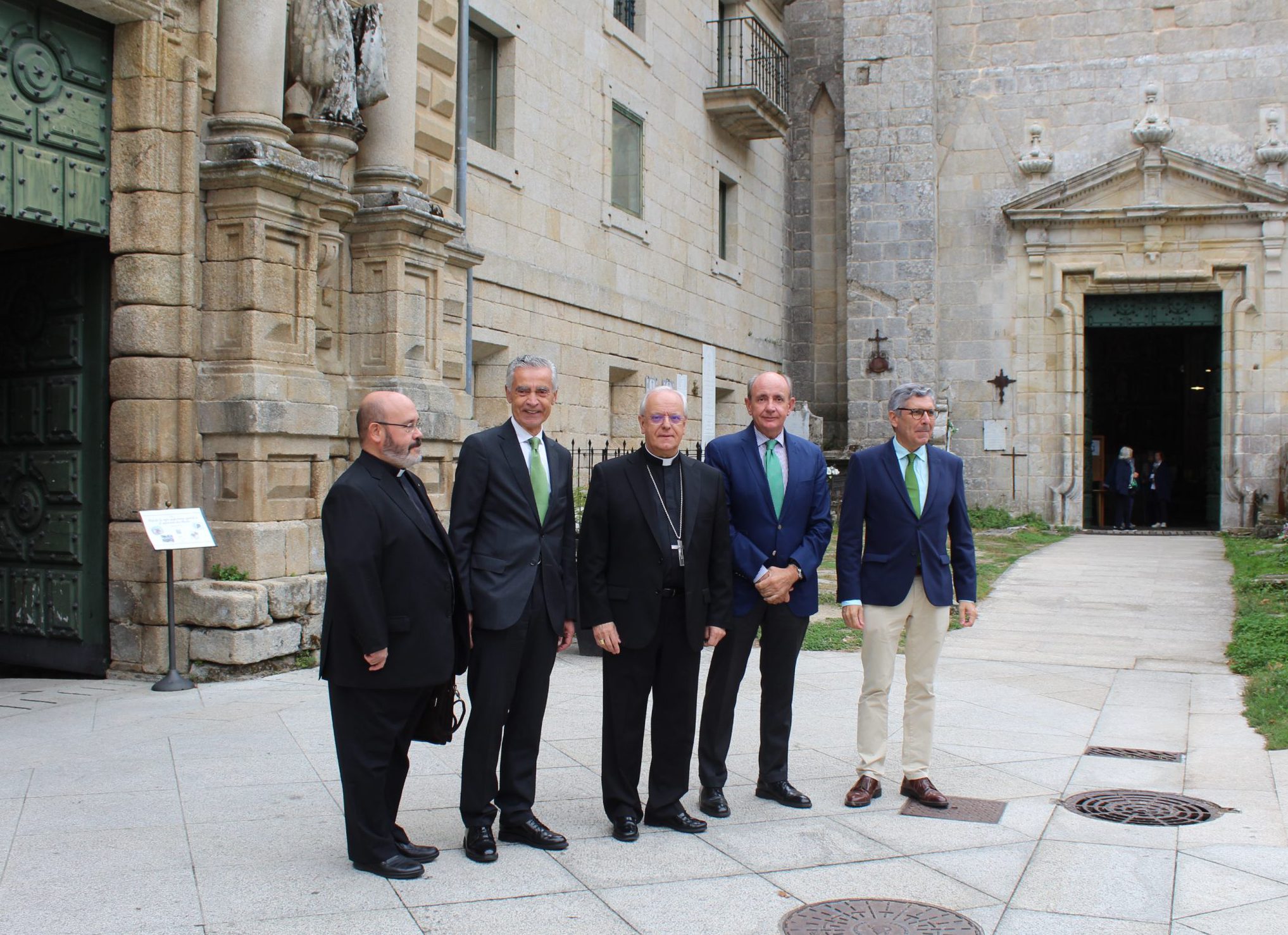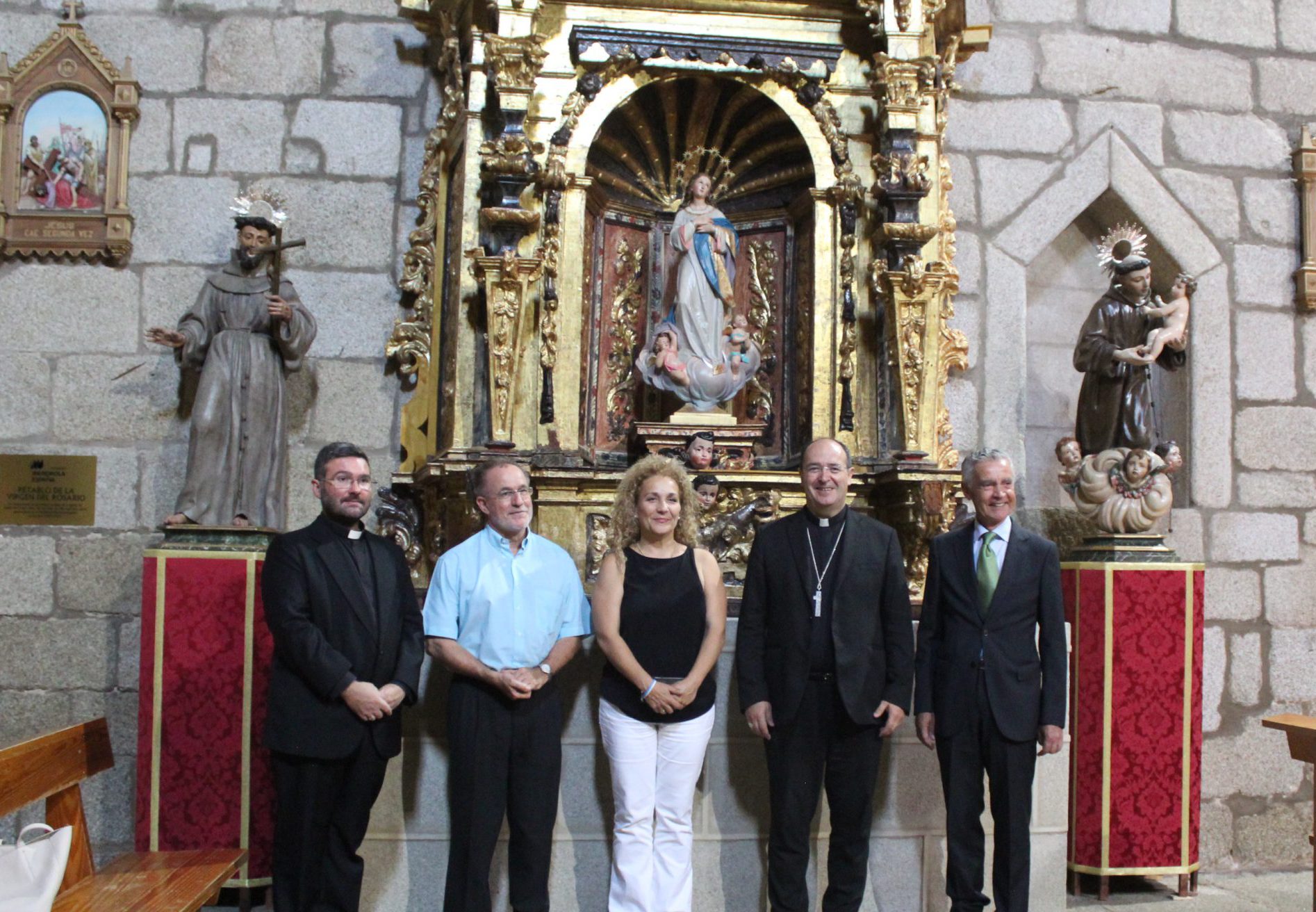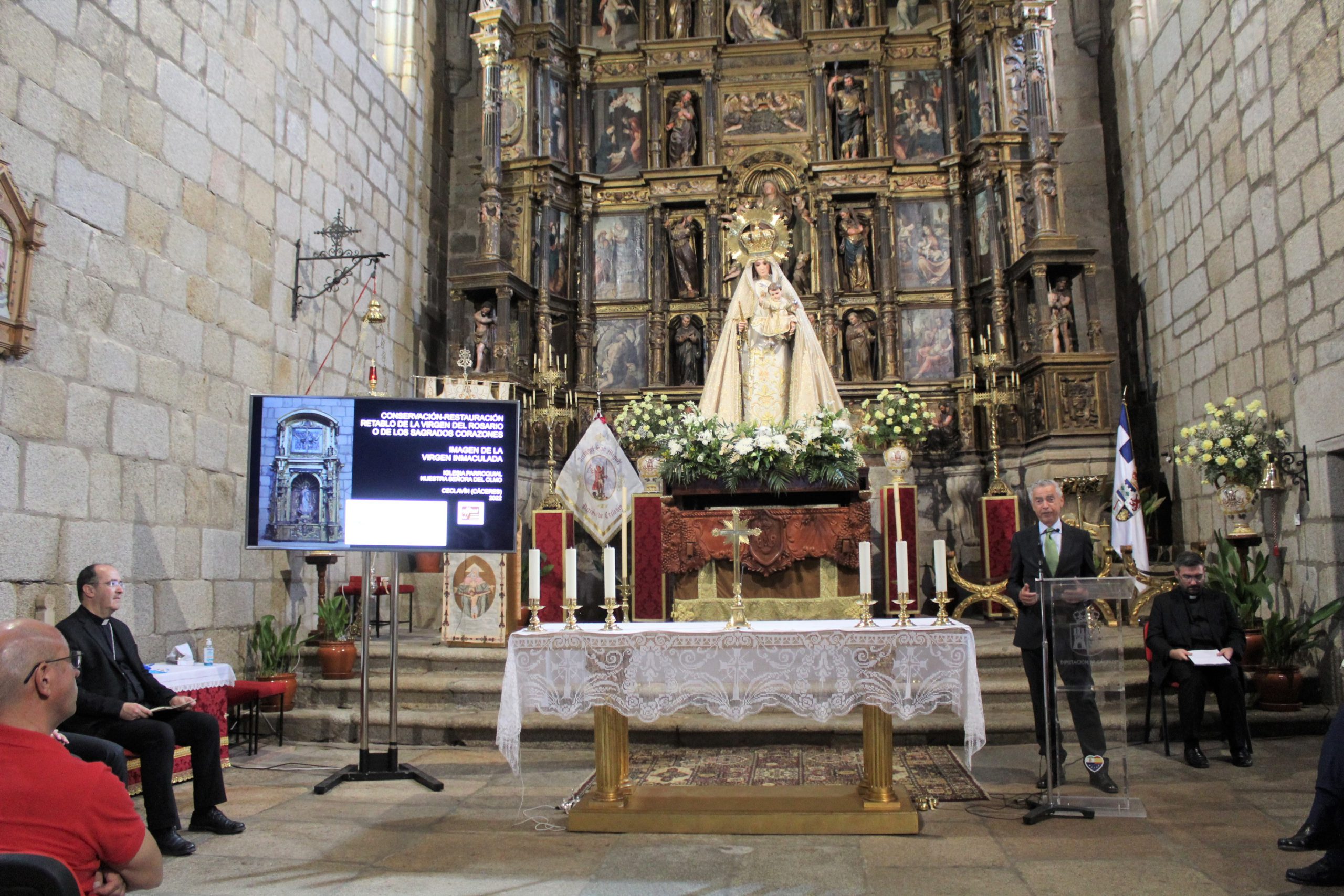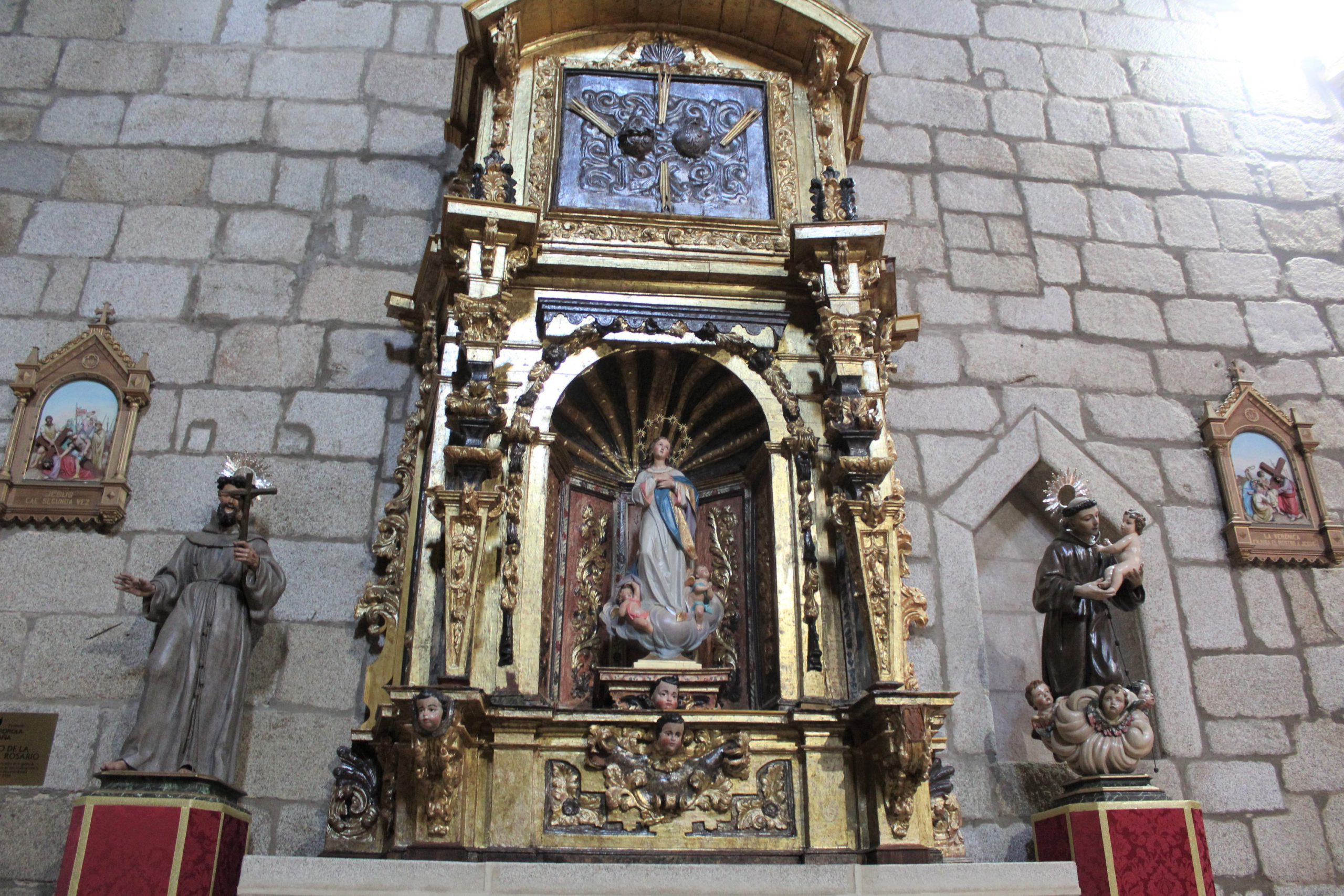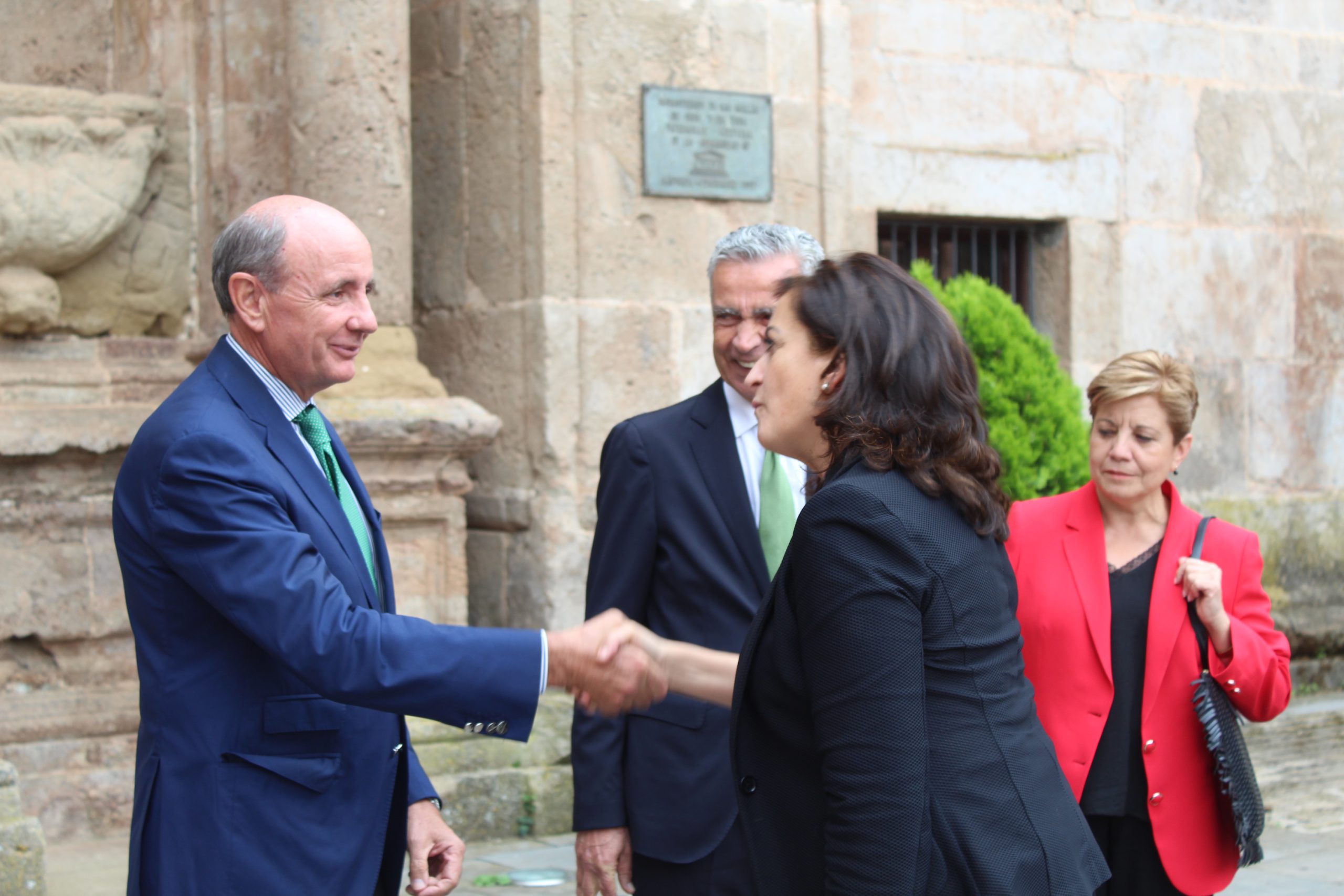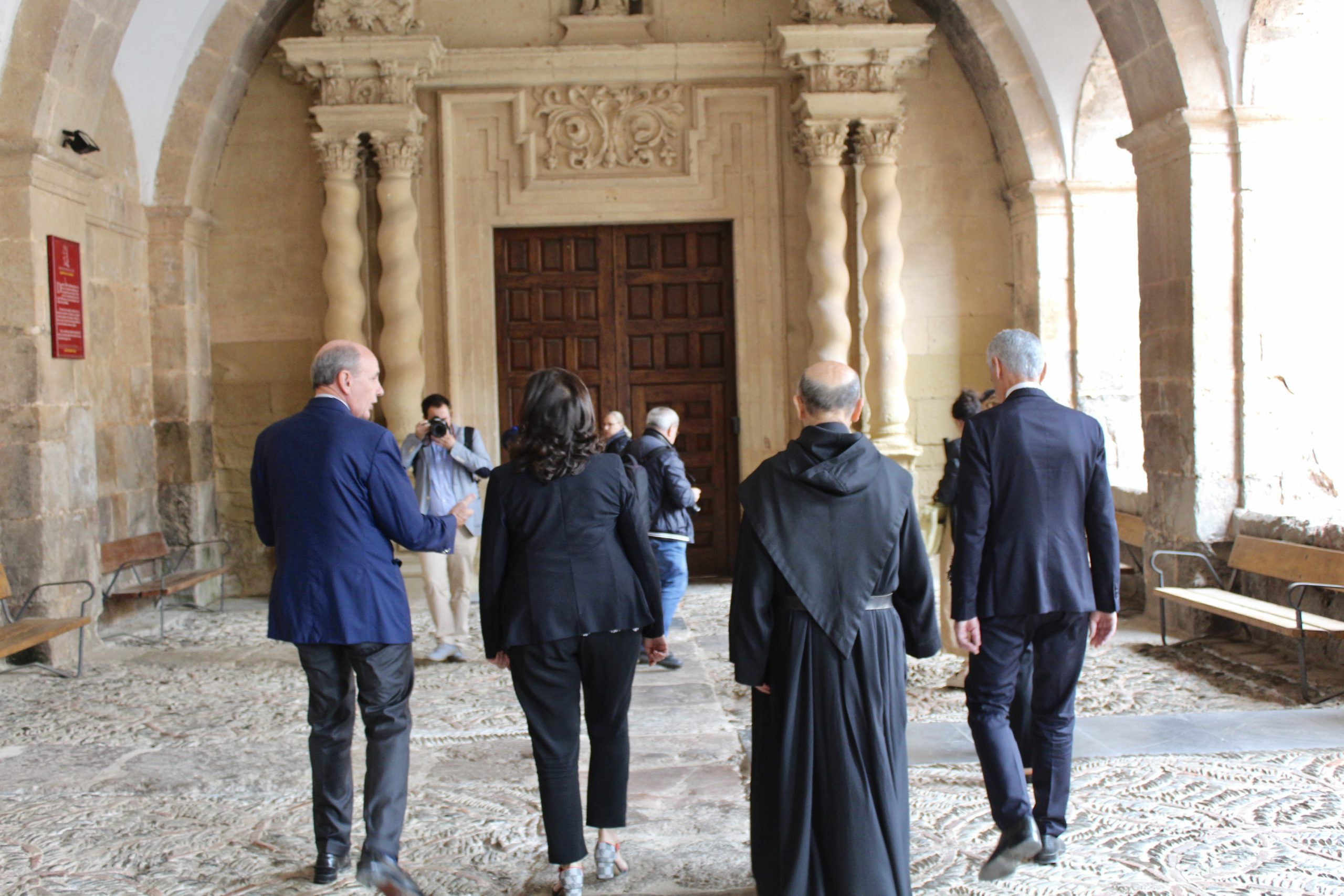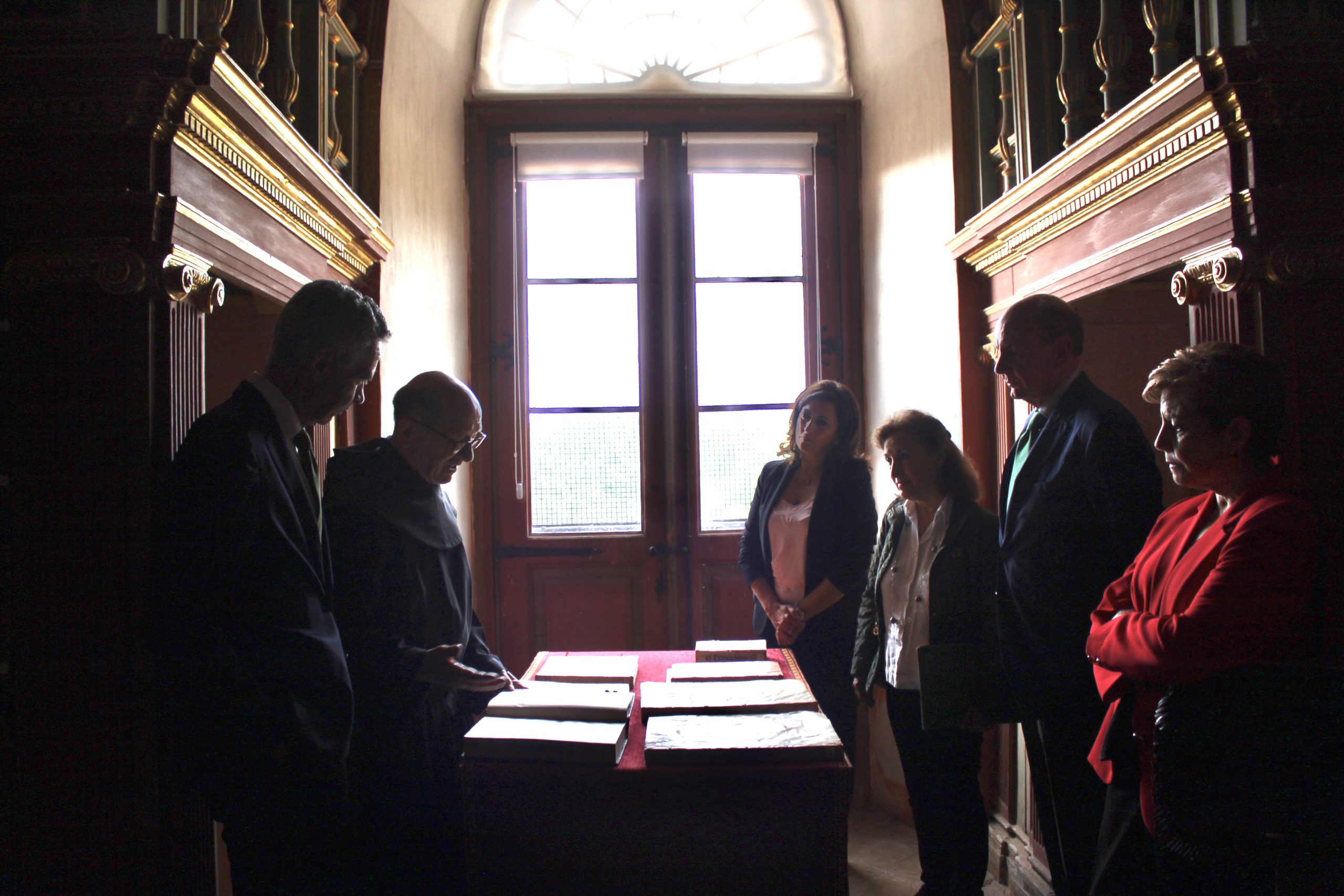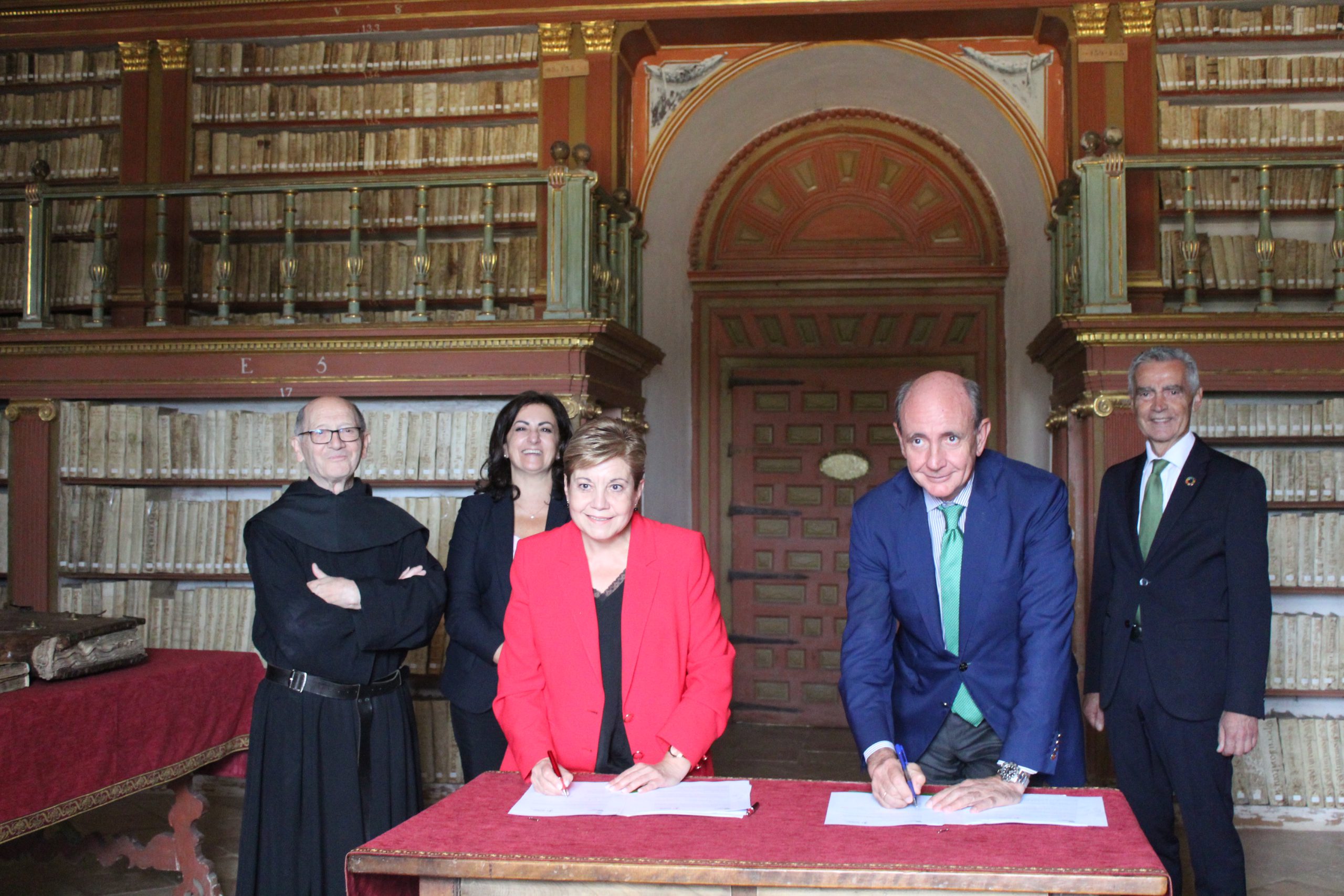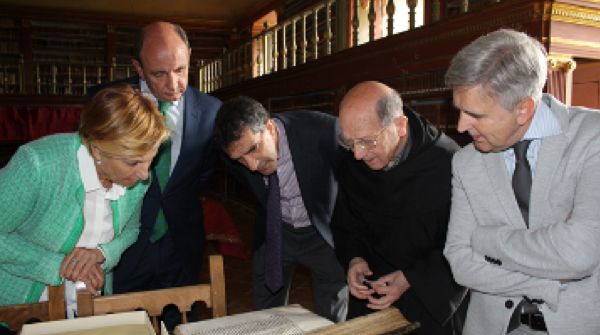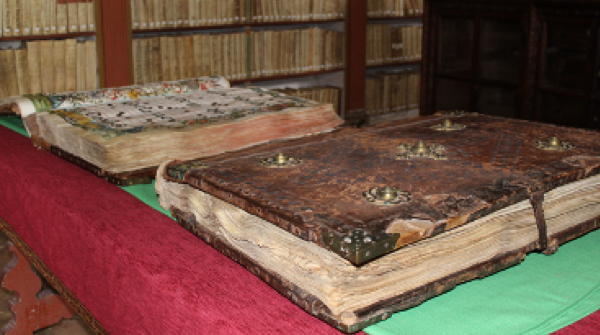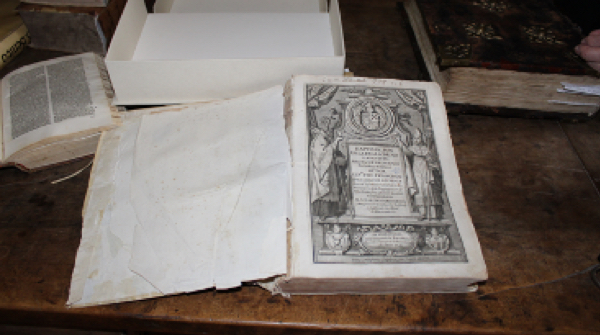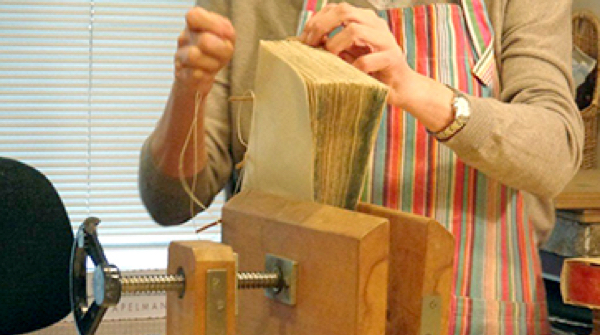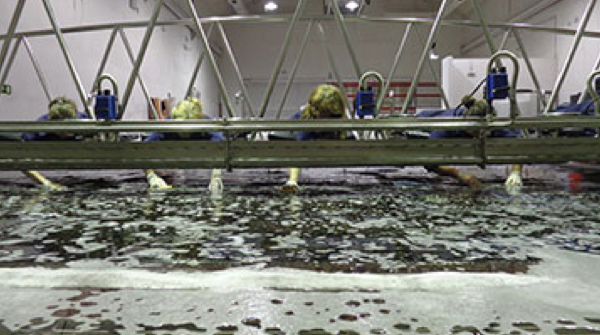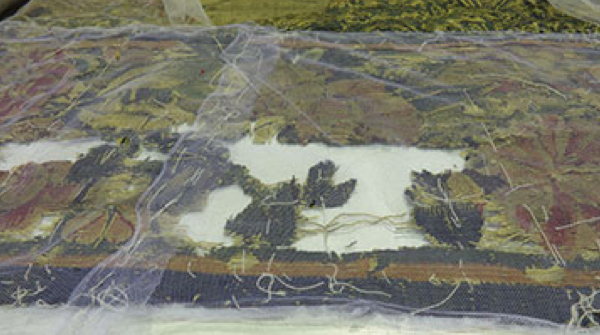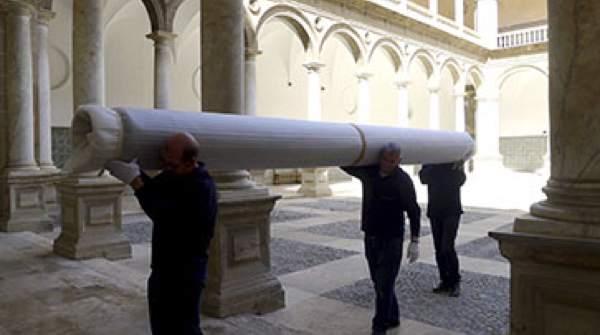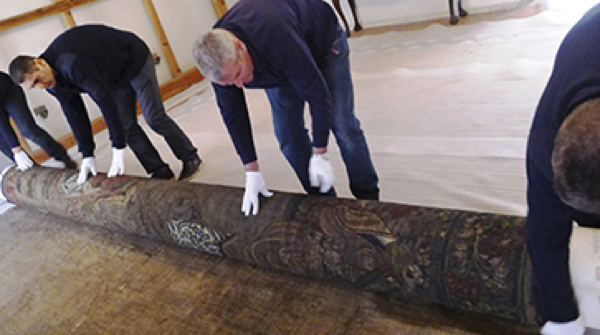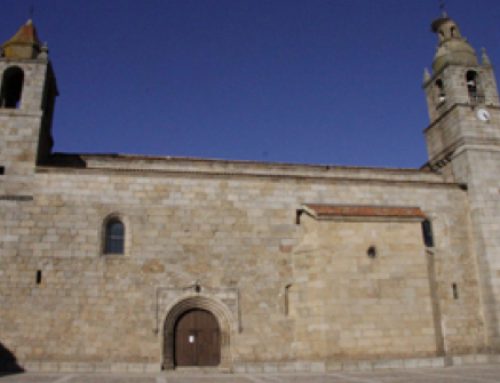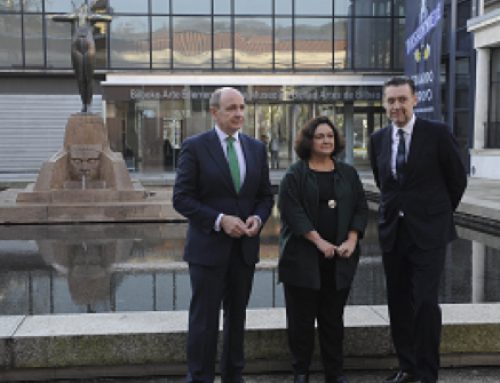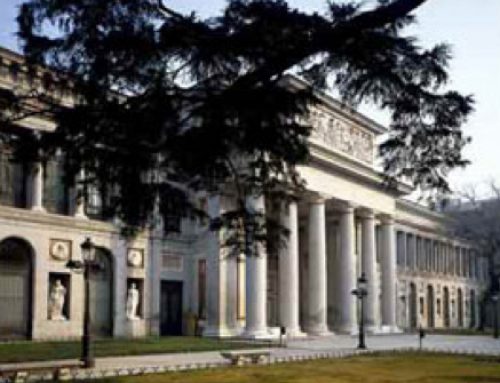As part of our commitment to preserving the art, culture and history of our heritage, we carry out multiple restoration and conservation projects in collaboration with different organisations. These include:
- This action includes the volumetric reintegration, cleaning, and repair of some ashlars located on the north side of the courtyard of this Renaissance building
- The agreement was signed by the president of Fundación Iberdrola España, Fernando García, and the managing director of the Fundación Museo del Ejército, Francisco Ramos, in the presence of authorities from the Institute of Military History and Culture and the General Military Archive of Ávila
Fundación Iberdrola España and the Fundación Museo del Ejército have signed an agreement to carry out a project to restore two lintels in the courtyard of the Palacio de Polentinos, in the capital of Ávila, property of the Spanish Army and headquarters of the General Military Archive of Ávila.
The agreement was signed this morning in the capital of Avila by the president of Fundación Iberdrola España, Fernando García, and the managing director of the Fundación Museo del
Ejército, Francisco Ramos, in the presence of the director of the Institute of Military History and Culture, Antonio Ruíz, authorities from the Directorate of Economic Affairs of the Army and the General Military Archive of Avila.
This action includes the volumetric reintegration of the lost pieces of two lintels of the courtyard of this two-story Renaissance building, with five monolithic columns, topped by footings and friezes with a plateresque decoration of coats of arms and plants.
The passage of time and inclement weather have caused the deterioration and loss of some ashlars located on the north side of the courtyard, which will be cleaned and repaired thanks to this agreement.
The Polentinos Palace, declared an Asset of Cultural Interest, with the category of national monument, since December 1999, was built at the beginning of the 16th century, in the Renaissance style. It should be noted that the layout and decorative richness of its façade make it one of the most important in the city.
This initiative is yet another example of Iberdrola’s commitment to Castilla y León and its permanent aim to promote the social value of culture and the conservation of the region’s historical and artistic heritage.
The Institute of Military History and Culture is grateful to Iberdrola for its ongoing interest in promoting art and culture, especially in the field of the Army, as evidenced by this collaboration in such a special monument for the city of Ávila.
Iberdrola, with the promotion of art and culture
One of Iberdrola’s main areas of action, through its foundation in Spain, focuses on the care, conservation, and enhancement of historical and artistic wealth.
Together with the Portuguese Ministry of Culture and the Regional Government of Castilla y León, the company is carrying out an ambitious project to restore and maintain the monuments of Romanesque art in 24 temples: 13 located in northern Portugal and 11 in Spain in the vicinity of the Duero and Támega rivers (in Salamanca and Zamora).
This public-private initiative called the Atlantic Romanesque Intervention Plan, seeks to recover the cultural, natural, and social heritage of the region, carry out a socioeconomic revitalization project and strengthen cross-border ties between Spain and Portugal.
It is also worth mentioning the Lighting Program, whose main objective is to develop interventions in unique buildings to install or improve their interior and/or exterior lighting systems to contribute to the enhancement of heritage.
Since 2011, the volume of investment allocated by Fundación Iberdrola to the Lighting Program has amounted to more than 3 million euros and has involved the improvement of over 40 monuments in Spain, including the exterior of the Cathedral of Ávila, the interior of the Cathedral of Palencia and the New Cathedral of Salamanca, the church of San Hipólito el Real in Palencia, the historic Roman Bridge of Alcántara in Cáceres, the façade of the Congress of Deputies, the Palace of the Supreme Court in Madrid, the Cathedral of Santiago de Compostela, and the Cathedral of Sigüenza.
- Fundación Iberdrola España and the Army Museum Foundation signed a collaboration agreement in March 2022.
- This restoration has involved an investment of 55,000 euros
Iberdrola, through its foundation in Spain, has completed the restoration work on the double stone Sepulcher of the Chapter House of the Convent of Santo Domingo, currently the headquarters of the High Readiness Ground Headquarters (CGTAD) in the former Captaincy General of Valencia, known as the Sepulcher of the Boil, to preserve and enhance the cultural heritage of the Valencian Community.
The project, which has involved an investment of 55,000 euros, is part of one of the main areas of activity of the Fundación Iberdrola España: cultural development and conservation of historical and artistic heritage.
The ceremony was attended by Lieutenant General Fernando Garcia-Vaquero, head of CGTAD; the president of Fundación Iberdrola España, Fernando García; and the director of Fundación Iberdrola España, Ramón Castresana.
Among other actions, the Valencian company NOEMA Restauradores has proceeded to the mechanical dry cleaning, the elimination of improper mortar, the measurement of salts inside the work, the consolidation of the stone material and the pre-existing pictorial strata, the chemical cleaning of the stone and the polychrome strata, the restoration of the gilded surfaces and the reconstruction and illumination studies of the work.
This action, another example of Iberdrola’s commitment to Valencia, is in addition to the projects that the company has carried out in recent years in the city through its Foundation, such as the restoration of the tapestries of the Colegio del Patriarca and the installation of new lighting in the Chapel of the Holy Chalice of the Cathedral.
The Sepulcher of the Boil family
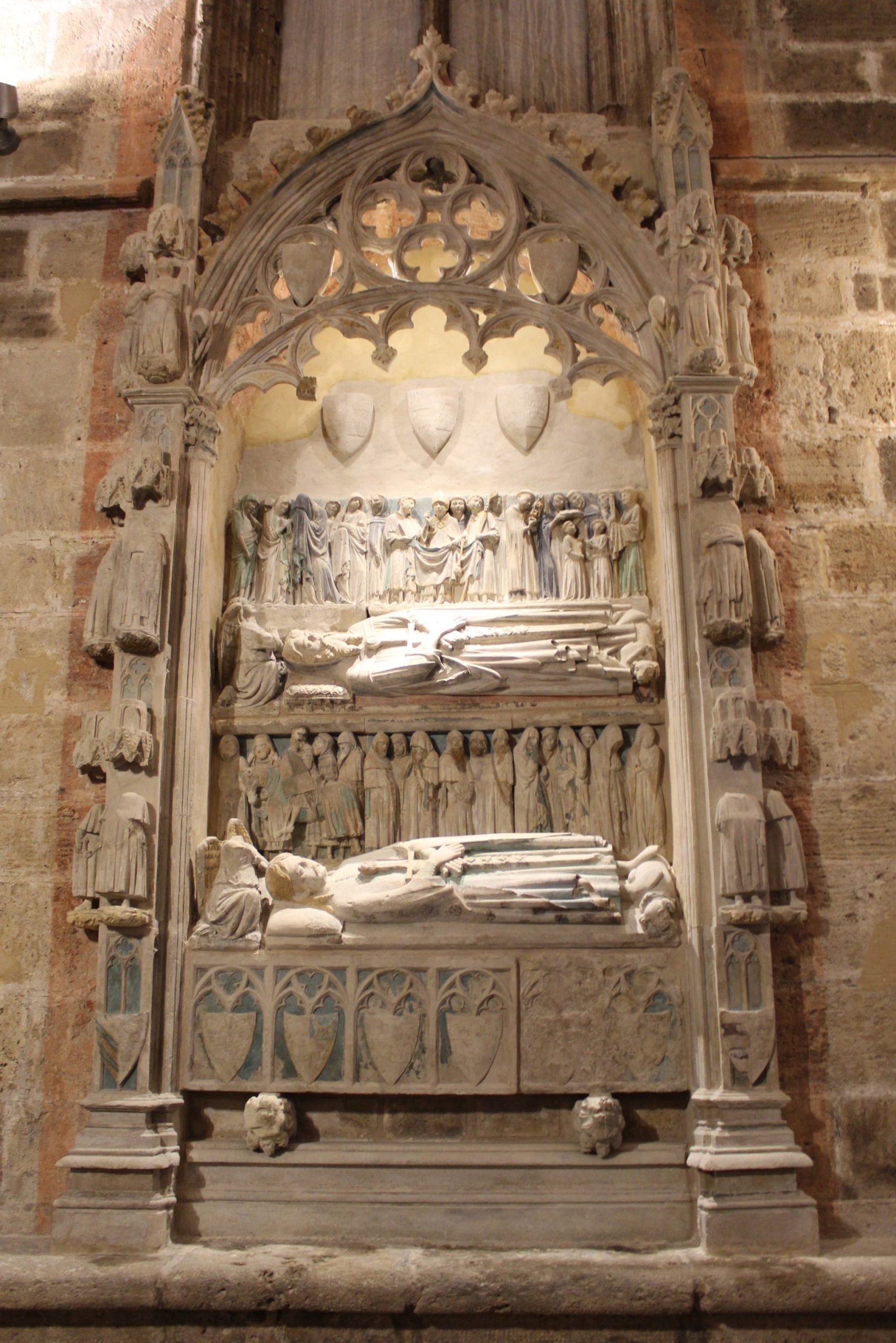
The sepulcher is located inside an arcosolium, measures 4.18 meters high X 1.65 meters wide, and was commissioned by Berenguer Vives Boil in the mid-fifteenth century.
In its interior lie the remains of D. Ramón de Boil Dies, II Lord of Bétera, known as “Old Governor” killed on January 6, 1407, and buried in the lower part, and of his son D. Ramón de Boil Montagut, III Lord of Bétera and viceroy of Naples in the reign of Alfonso V the Magnanimous, who died in 1458, whose remains are housed in the upper part.
The work, made on calcarenite-type sandstone and by an unknown author, is articulated employing two columns that support an archivolt. The tomb has a cinerary, a lower recumbent statue, a lower frieze, an upper recumbent statue, and an upper frieze.
Fundación Iberdrola España with culture
Fundación Iberdrola España carries out interventions in artistic monuments and unique buildings to install or improve indoor and/or outdoor lighting to contribute to the enhancement of historical and artistic heritage and improve the energy efficiency of these systems.
Since 2010, the Foundation has also been developing an ambitious project for the restoration and maintenance of Romanesque art monuments in Spain and Portugal, the Atlantic Romanesque Plan, a cross-border cooperation project developed together with the Portuguese Secretary of State for Culture and the Regional Government of Castilla y León, whose second phase is progressing well, promoting the sustainable socio-economic growth of the territory, based on its resources: the people who live there, its natural environment and its cultural heritage.
- A 50,000€ project for the mechanization of the opening of the reliquary cabinets of the Church of Santo Estevo.
- Thanks to this mechanization, it will be possible to see the late Gothic mural paintings that have been recovered by the Diocese.
Iberdrola, through its foundation, has signed today an agreement valued at 50,000 euros to develop a project to mechanize the opening of the reliquary cabinets of the “Santos Nueve Obispos” of the church of Santo Estevo, Orense.
The agreement was signed this morning in this Galician municipality by His Excellency Leonardo Lemos Montanet, Bishop of the Diocese of Orense, and the President of the Fundación Iberdrola España, Fernando García Sánchez.
During the restoration of the reliquaries of the church, an exceptional set of late Gothic (15th century) mural paintings were discovered when some tastings were made in the lime that covered the wall. This project proposes the creation of a mobile machine that will allow the reliquaries to be put back in their original place but that can be moved to allow the paintings on the wall to be seen.
Among other actions, the project will include the installation of a system of articulated axes with a metallic structure on which the reliquaries will be placed and the creation of 3D plans and kinematic designs for an optimal technical solution.
This new initiative, which will have an investment of 50,000€ is another example of Iberdrola’s commitment to Galicia and its ongoing aim to promote the social value of culture and the conservation of the region’s historical and artistic heritage.
Parish Church of Santo Estevo de Ribas de Sil
The monastery of Santo Estevo de Ribas del Sil is a monastic complex, now in disuse, located in the parish of the same name in the municipality of Nogueira de Ramuín, in the Ribeira Sacra region of Galicia. At present, it has been converted into a Parador de Turismo.
On the façade of the enormous monastery, there is a coat of arms carved in granite that represents nine miters. They are those corresponding to the nine bishops who lived around the 10th century and spent their last years in retirement in Santo Estevo and who are venerated as saints on January 26, although they are not formally canonized. The fame of the supernatural prodigies of the nine religions and their rings attracted many pilgrims and generous donations that contributed to the enlargement and embellishment of the monastery, which later passed into the hands of the Benedictines. Already in the 15th century, his remains were transferred to two golden coffers that have flanked the main altar of the church ever since.
In December 2020, during the restoration of one of the reliquaries, a small silk bag was found with four rings and a note that warns of the absence of the other five.
Iberdrola, promoting art and culture
Since its creation, Iberdrola has been committed to the energy, cultural and social development of the communities in which it operates. In this regard, Fundación Iberdrola España represents a further step in this commitment, by promoting initiatives that contribute to improving people’s quality of life. One of the main areas of action of the Foundation focuses on the care, maintenance, and promotion of art and culture.
Since 2011, it has allocated over three million euros. This investment has meant the improvement of more than 40 monuments in Spain. Of particular note is the work on the historic Roman Bridge of Alcántara, in Cáceres; the facade of the Supreme Court, in Madrid; the Sigüenza Cathedral, and the interior of the Santiago de Compostela Cathedral.
- The restoration of the altarpiece, which has involved an investment of 33,880 euros, is another of Iberdrola’s commitments to Extremadura
- The works have restored the splendor of the altarpiece and remedied the deterioration caused by the passage of time
The Coria – Cáceres Diocese has completed the restoration of the altarpiece of the Virgin of the Rosary (Sacred Hearts) belonging to the Church of Santa María del Olmo.
Fundación Iberdrola España signed the agreement with the Diocese of Coria – Cáceres in November 2021 to recover the movable cultural heritage of historical and artistic value of the Church of Santa María del Olmo. Specifically, the Altarpiece of the Virgin of the Rosary (Sacred Hearts), includes the recovery of the sculpture of the Immaculate Conception.
Among other actions, cleaning of the mechanical surface of organic remains and accumulated dirt has been carried out, fixing the pictorial layer by injection and application of brushing, assembly and disassembly of infrastructure, and restoration of the image of the Immaculate Virgin.
This morning the ceremony was attended by Monsignor Jesús Pulido, Bishop of the Diocese of Coria-Cáceres; Mr. Mario Méndez Ramos, parish priest; Ms. Inmaculada Lucas, mayoress of Ceclavín; Mr. Fernando García, president of Fundación Iberdrola España and Mr. Francisco Pérez Urban. General Director of Libraries, Archives, and Cultural Heritage of the Ministry of Culture, Tourism, and Sports of the Regional Government of Extremadura.
The restoration of the altarpiece, which has involved an investment of 33,880 euros, is another of Iberdrola’s commitments to Extremadura and its permanent aim to promote the social value of culture and the conservation of the region’s historical and artistic heritage.
The church of Santa María del Olmo and the Altarpiece of the Virgin of the Rosary (Sacred Hearts)
The church of Santa María del Olmo is a complex work that encompasses different architectural styles such as Renaissance and Baroque and was declared BIC (Bien de Interés Cultural) in 1982.
The altarpiece of the Virgin of the Rosary also called of the Sacred Hearts, is one of the two altarpieces that were conserved in the hermitage of the Holy Christ of the locality, although they belonged to the greater temple until the post-conciliar reform of the last century decided to relieve the church of many of its old altarpieces, eliminating some and moving others. Due to the advanced state of degradation of the hermitage, caused by the high levels of humidity, it was decided to remove them from the hermitage and take them to the parish building, where they are now waiting to be put back on their feet.
Fundación Iberdrola with culture
Since its creation, Iberdrola has been committed to the energy, cultural and social development of the communities in which it is present. In this regard, Fundación Iberdrola España represents a further step in this commitment by promoting initiatives that improve people’s quality of life. One of the Foundation’s main areas of action focuses on the care, maintenance, and promotion of art and culture.
This project is in addition to others that the company has carried out in Castilla-La Mancha in recent years, including the illuminations of the Monastery of Uclés, the Basilica of Nuestra Señora del Prado in Talavera de la Reina, and the Cathedral of Sigüenza, among others, as well as exhibition projects such as El Prado en las calles.
- The agreement with the monastery to recover its library has been renewed in a ceremony attended by the President of La Rioja and the President of the Fundación Iberdrola.
- The copies require immediate intervention due to their value and their current state.
Fundación Iberdrola España and the Fundación San Millán de la Cogolla have renewed the collaboration agreement that will allow them to continue with the recovery of part of the collections of the Monastery of Yuso library.
After receiving the approval of the Augustinian Fathers, owners of the library, and the Commission of Artistic-Historical Heritage of La Rioja, this new agreement with the Fundación Iberdrola España will allow the restoration of six codices from the 15th, 16th, and 17th centuries that require urgent intervention due to their value and delicate state of conservation.
The director of Fundación Iberdrola España, Ramón Castresana, and the general coordinator of Fundación San Millán de la Cogolla, Almudena Martínez, signed the agreement at a ceremony this morning, in the presence of the president of La Rioja and of Fundación San Millán de la Cogolla, Concepción Andreu, the president of Fundación Iberdrola España, Fernando García, and the prior of the Monastery of Yuso, Pedro Merino.
Iberdrola, through its foundation, has been collaborating since 2012 for the recovery of documentary collections of the Monastery of Yuso, declared a World Heritage Site by UNESCO on December 4, 1997, considered the cradle of the Spanish language for possessing one of the most important monastic libraries in the Hispanic sphere.
Since the Fundación San Millán de la Cogolla began the enormous task of restoring the library in 2003, nearly 400 volumes have already been restored. Specifically, over the last ten years, the Fundación Iberdrola España has collaborated in the restoration of a total of 46 highly valuable codices.
The selection of the set of codices has been made by Father Pedro Merino and Ana Jessen, in whose workshop the restoration will be carried out. The state of conservation is very varied; in general terms, the covers show damage resulting from loss of support due to use, poor handling, format, problems of dehydration of the skin and parchment, and general dirt and stains of unknown origin. The paper also shows deterioration caused by use, such as general soiling, humidity stains, losses, tears, deformations, and attacks by bibliophage insects.
Iberdrola has been collaborating with the Fundación San Millán de la Cogolla for several years, in which it has participated in projects such as the restoration of the latticework of the High Altar of the Monastery of Yuso and the refurbishment of the Exhibition Hall. Another collaboration agreement for the interior and exterior lighting of the Monastery was also completed.
Fundación San Millán de la Cogolla and the Monastery of Yuso and Suso
The purpose of the Fundación San Millán de la Cogolla is to protect and care for the monasteries of Suso and Yuso; to research, document, and disseminate the Spanish language; and to promote the social, economic, cultural, and tourist development of San Millán de la Cogolla and its surroundings.
It also acts as a cohesion agent for all administrations, institutions, associations, companies, and individuals committed to the protection and dissemination of this place, both nationally and internationally.
The Monasteries of Suso and Yuso in San Millán de la Cogolla (La Rioja) were declared a World Heritage Site by UNESCO in 1997 because they represent an exceptional testimony to the introduction of Christian monasticism in the 6th century and its continued survival to the present day, and for being the place where the first written manifestations of the Spanish language appeared.
Fundación Iberdrola with culture
Since its creation, Iberdrola has been committed to the energy, cultural and social development of the communities in which it is present. In this regard, Fundación Iberdrola España represents a further step in this commitment, by promoting initiatives that contribute to improving people’s quality of life. One of the Foundation’s main areas of action focuses on the care, maintenance, and promotion of art and culture.
This project is in addition to others that the company has carried out in recent years, including the illuminations of the facade of the Palacio de los Chapiteles in Logroño, the Monastery of Guadalupe, the Roman Bridge in Talavera de la Reina, and the Plaza Mayor in Sigüenza, among others, as well as exhibition projects such as El Prado en las Calles.
- The works have been carried out by the Escuela Superior de Conservación y Restauración de Bienes Culturales de Madrid.
- The Fundación Iberdrola España has defrayed the costs of the recovery of the altarpiece of San Fabián and San Sebastián and the work is already in the temple.
The Escuela Superior de Conservación y Restauración de Bienes Culturales de Madrid (Escrbcm) has completed the restoration of the altarpiece of San Fabián y San Sebastián of the Cathedral of Cuenca and has returned it to the temple.
Fundación Iberdrola España signed the agreement with Escrbcm in August 2019 to collaborate in the training of the School’s students during the following two academic years. Specifically, it has facilitated the practice of treatment of the first-rate cultural property.
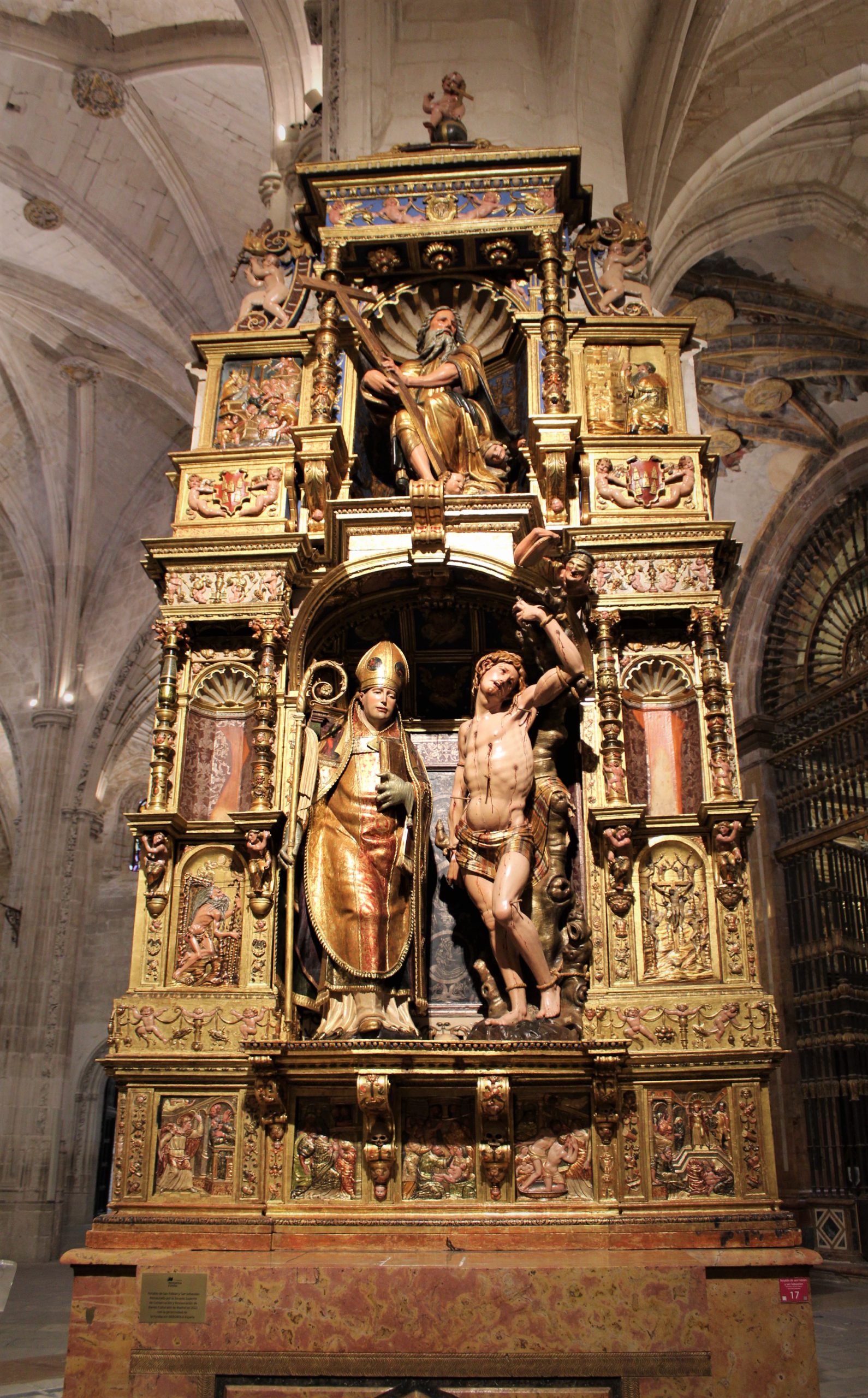
The restoration work on these pieces has been directed by Professor Luis Priego. They consisted of the dismantling and transfer to the School’s facilities in Madrid, where students from different classes were able to participate in the restoration process.
Among other actions, dry cleaning has been carried out with fine-haired brushes and pressurized air to remove accumulations of dirt. Also, the replacement of lost elements by a pantograph, the cleaning of polychromes through mechanical and chemical procedures, and the varnishing of these to ensure their protection.
This morning the ceremony was attended by Monsignor José María Yanguas Sanz, Bishop of Cuenca; José Antonio Fernández Moreno, Dean-President of the Cathedral Chapter; Fernando García Sánchez, president of the Fundación Iberdrola España; and Ruth Viñas Lucas, director of the School of Conservation and Restoration of Cultural Heritage.
The restoration began in 2019 but, due to the restrictions of the Covid 19 pandemic and the closure of the classrooms, it has taken almost three years to complete the restoration. The Altarpiece of Saint Fabian and Saint Sebastian is a work by Diego de Tiedra, dating from the mid-16th century and owned by the Cathedral of Cuenca.
This collaboration of Fundación Iberdrola España is another example of its commitment to the promotion, recovery, and conservation of historical and artistic heritage, as well as supporting the training of a new generation of professionals capable of driving the transformation towards a sustainable energy model.
Fundación Iberdrola with culture
Since its creation, Iberdrola has been committed to the energy, cultural and social development of the communities in which it is present. In this regard, Fundación Iberdrola España represents a further step in this commitment by promoting initiatives that contribute to improving people’s quality of life. One of the Foundation’s main areas of action focuses on the care, maintenance, and promotion of art and culture.
This project adds up to the others that the company has carried out in Castilla-La Mancha in recent years, including the illuminations of the Monastery of Uclés, the Basilica of Nuestra Señora del Prado in Talavera de la Reina, and the Plaza Mayor in Sigüenza, among others, as well as exhibition projects such as El Prado en las calles.
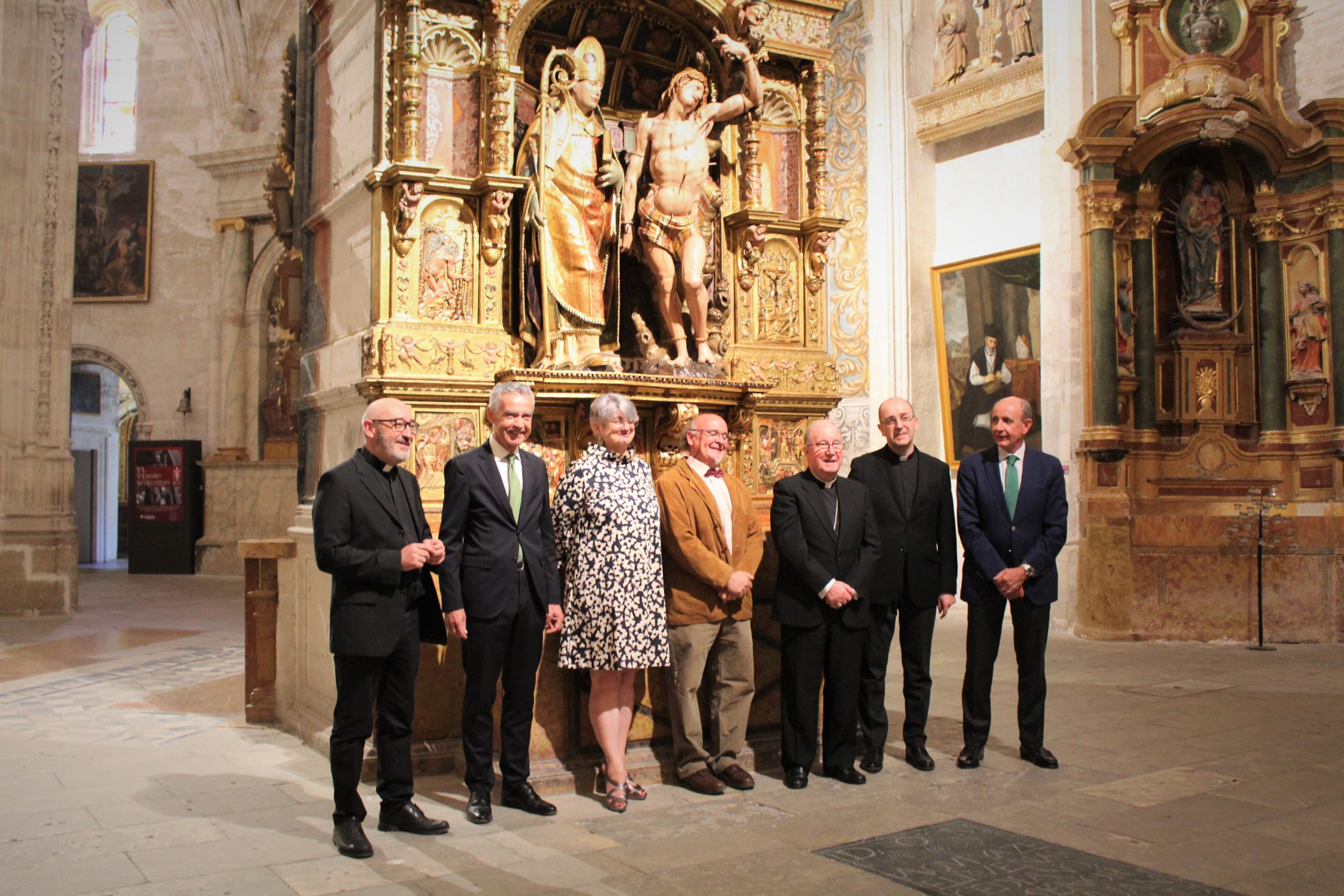
- Through its foundation, Iberdrola has carried out the restoration of the San Antonio de Padua’s altarpiece with an investment of 44,700 euros.
- The mayoress of Ceclavín, Inmaculada Lucas, the diocesan administrator and vicar general of the Coria-Cáceres diocese, Diego Zambrando, and the president of Fundación Iberdrola España, Fernando García Sánchez, have inaugurated today the restored altarpiece.
Ceclavín, Cáceres. Through its Spanish foundation, Iberdrola has finished the restoration process of the San Antonio de Pauda’s altarpiece in the municipality of Celavín, to preserve and enhance Extremadura’s cultural heritage.
The project, which required an investment of 44,700 euros, belongs to one of the main areas of activity of Fundación Iberdrola España: cultural development and preservation of the historical and artistic heritage.
The event was attended by the mayor of Ceclavín, Inmaculada Lucas, the diocesan administrator and vicar general of the Coria-Cáceres’ diocese, Diego Zambrando, and the president of Fundación Iberdrola España, Fernando García Sánchez.
The restoration works have comprised the treatment of the images of the Holy Trinity, St. John the Baptist, and the Virgin of the Remedies. There were several problems with the altarpiece, all of them mainly caused by the passage of time and the lack of maintenance of the properties they are kept in, where humidity and sudden oscillations of temperature contributed to its deterioration.
Among other acts, the restoration team has executed a mechanical cleaning of the accumulated organic remains, set the pictorial stratum, applied treatment against xylophagous insects, structural carpentry, and the restoration of the altarpiece.
The restoration of the San Antonio de Padua’s altarpiece is another example of Iberdrola’s commitment to Extremadura and its permanent purpose of promoting culture’s social value and the preservation of the region’s historical and cultural heritage.
Nuestra Señora del Olmo church
Nuestra Señora del Olmo church, declared of cultural interest in 1982, is a stone building with a nave covered with starry vaults, a sturdy terraced tower next to the Presbytery, and a choir at the end. It is a Gothic-style building with hints of Renaissance and Baroque elements.
Fundación Iberdrola with culture
Fundación Iberdrola performs interventions in artistic monuments and unique buildings to install or improve the inside and-or outside lighting to contribute to the reevaluation of the historical and artistic heritage and improve energy efficiency on those systems.
This project aligns itself with the previous work that the foundation has performed in Extremadura over the last years, among which stands out the ornamental lighting of the Alcántara bridge and the Guadalupe monastery and the renovation of the Teatro del Conventual of San Benito de Alcántara lighting.
Fundación Iberdrola España visits the Higher School of Conservation and Restoration of Cultural Property
Higher School of Conservation and Restoration of Cultural Property (ESCRBC) is a centre of higher education dependent upon the Council for Education and Research of the Community of Madrid, whose primary purpose is to train higher education students to preserve and restore cultural assets. One important facet of this training is tutelage of students at the centre in real conservation and restoration projects.
On 16 August 2019, Fundación Iberdrola España signed an agreement with the Higher School of Conservation and Restoration of Cultural Property (ESCRBC) to collaborate in the training of students at the school during the 2019-2020 and 2020-2021 academic year by providing practical teaching in conservation and experiences with an asset of historical-artistic values to enhance their knowledge and expertise, bringing more personalised and comprehensive value to their training.
This is being achieved with the invaluable assistance of Cuenca Cathedral, which has provided the Higher School of Conservation and Restoration of Cultural Property (ESCRBC) with the altarpiece of St Fabian and St Sebastian, a work by Diego Tiedra dating to the 16th century – owned by the Cathedral – for restoration by final-year students under the supervision and tutorage of their teacher Mr Luis Priego.
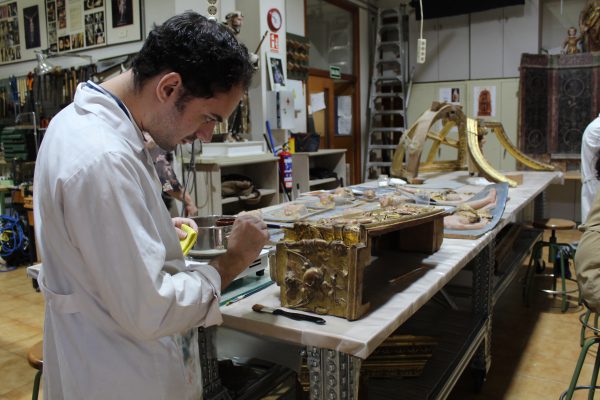
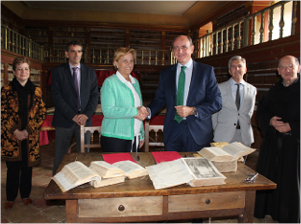
Fundación Iberdrola España and the Fundación San Millán de la Cogolla are working to restore codices from the 15th, 16th and 17th centuries.
In 2018, we renewed our collaboration with the Fundación San Millán to continue working to restore the collection belonging to the Yuso Monastery Library.
Nearly 400 volumes have now been restored since the Fundación San Millán de la Cogolla began the enormous task of restoring the Library in 2003. After receiving the consent of the Augustinian Friars, who own the Library, and the La Rioja Historical-Artistic Heritage Commission, this new agreement provides for the restoration of seven codices from the 15th, 16th and 17th centuries that require urgent attention due to their value and delicate state of conservation.
The codices were chosen by Father Pedro Merino and Ana Jessen, in whose workshop the restoration will take place. The state of conservation is very varied:
- Many have damaged covers resulting in a loss of integrity; this damage is due to their use, mishandling, the dehydration of the leather or parchment, general dirtiness and stains of unknown origin.
- The paper had also deteriorated through use giving rise to general dirtiness, damp stains, tears, warping and damage from bookworms.
We have collaborated with the Fundación San Millán de la Cogolla for several years, during which time we have also participated in the restoration of the latticework around the high altar at Yuso Monastery and in refurbishing the Exhibition Hall. We also entered into another collaboration agreement for the interior and exterior lighting at the Monastery.
- The aim of the Fundación San Millán de la Cogolla is to protect and care for the natural environment in an area in San Millán de la Cogolla that has been declared a World Heritage Site. The foundation researches, documents and is a source for information on the origins of the Castilian language. It uses the latest technologies to provide information and update the Spanish language throughout the world. It also promotes the social, economic, cultural and tourist development of San Millán de la Cogolla and its surroundings.
- The Suso and Yuso Monasteries in San Millán de la Cogolla, which were the cradle of the Spanish language, were declared a World Heritage Site by UNESCO on 4th December 1997, for artistic, religious, linguistic and literary reasons as they have one of the most important monastic libraries in the Hispanic world. A total of 18 codices have now been restored by the Workshop Training Centre run by restorer Ana Jessen in Madrid, focusing on those books that were in most desperate need of repair. Launched in late 2013, this restoration project has been undertaken in various phases, starting with an in-depth study into the condition of each codex to establish how best to treat each individual case based on the particular damage and its causes.
Media error: Format(s) not supported or source(s) not found
Download File: https://cdnapisec.kaltura.com/p/1843481/sp/184348100/playManifest/entryId/1_ozzxg3d5/flavorId/1_aj1myhly/format/url/protocol/https/a.mp4?_=1To restore the codices, their condition is carefully analysed and individual treatments are established.
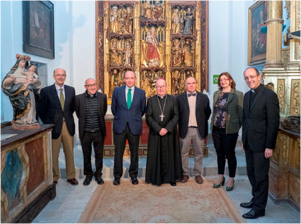
Fundación Iberdrola España and the Madrid School of Conservation and Restoration of Cultural Assets have completed the restoration of the altarpiece in Santa María y Todos los Santos (Cuenca Cathedral).
The restoration of the altarpiece in Santa María and Todos los Santos Cathedral in Cuenca was finished in 2018. It has been returned to the cathedral and placed in a new location inside its chapel, due to the excellent outcome of the restoration process. The work was been carried out in collaboration with the Madrid School of Conservation and Restoration of Cultural Heritage.
Ramón Castresana (director of Fundación Iberdrola España) together with Venancio Rubio (the company’s institutional delegate in Castilla-La Mancha), Monsignor José María Yanguas (bishop of Cuenca), José Antonio Fernández (dean president of the chapter), Ruth Viñas (director of the Madrid School of Conservation and Restoration of Cultural Heritage) and Luis Priego (professor and coordinator of the altarpiece restoration) met in the cathedral to admire the result of the restoration.
The restoration work on this Gothic piece from the end of the 15th century consisted of dismantling the piece and transferring it to the School’s facilities in Madrid. There, students from the fourth year of the degree course had the opportunity to participate in the restoration process. Exceptional results were obtained in returning all the parts to their original condition.
A total of 10 students from the Sculptural Conservation-Restoration course participated in the restoration process, which began in September 2017 and ended on schedule. The restoration of this piece was the second collaboration between the Fundación Iberdrola España and the School of Conservation and Restoration of Cultural Heritage after the one carried out between 2015 and 2016 on the Virgen del Rosario altarpiece in the church of Navamorales in Salamanca.
The project was made possible thanks to the invaluable support from Cuenca Cathedral and its Chapter House, which from the outset collaborated in every way possible with the School of Restoration and Iberdrola for the conservation of its heritage.
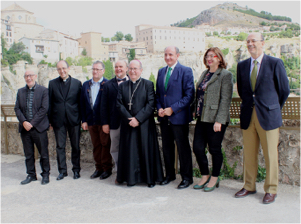
The restoration of this altarpiece is an example of our commitment to the conservation of historical-artistic heritage and the training of profession
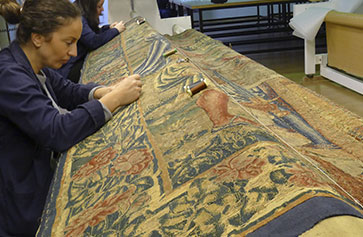
The flamenco tapestries in the Royal College of the Patriarch have undergone cleaning and restoration with the support of Fundación Iberdrola España.
One of the most valuable treasures held by the Royal College of the Patriarch is a series of six large Flemish tapestries, donated by its founder, Juan de Ribera, four of which are displayed hanging on the walls of the Monument Chapel (also known, for this reason, as the Tapestries Chapel). The panels date from the early 16th century, the period when Flemish tapestry production reached its greatest splendour.
Their precarious state of conservation required urgent action to restore them, as they had lost colour and deteriorated through the passing of time.
Work started in early 2013 to restore, clean and consolidate the tapestries, a task that was entrusted to the Royal Tapestry Factory in Madrid.
- After removing the linings and the numerous darns all over the tapestries, the restorers embarked on a new phase consisting of washing four of the six panels and dying the supports to cover the existing gaps.
- Once prepared, the next phase was to place four of the tapestries on a loom to stabilise them (La Gracia Pública de los Honores, El Pago del Denario, La Ira y la Pereza and Contratación de los Jornaleros) before starting the actual restoration.
- Restoration of the fifth tapestry in the series, El juicio de Salomón, took place in 2016, while the sixth and last of the tapestries that make up the collection, Exhortación a las Virtudes was restored in 2017.
Cleaning the tapestries is not only a matter of aesthetics, it is an essential task to halt their deterioration and clean up the fabric. In addition, removing materials from prior restorations will make it easier to conserve the tapestries in the future. This work will revive the colours that were concealed under a thick layer of accumulated smoke, while the elimination of the darns and the subsequent repairs to the cloth will consolidate the structural recovery of the tapestries and the visual reintegration of the decorative elements.
The restoration work, completed in 2017, was carried out with the utmost care and rigour and the entire process was documented step by step.
Media error: Format(s) not supported or source(s) not found
Download File: https://cdnapisec.kaltura.com/p/1843481/sp/184348100/playManifest/entryId/1_7q3jf3bs/flavorId/1_bctd4o0g/format/url/protocol/https/a.mp4?_=2
